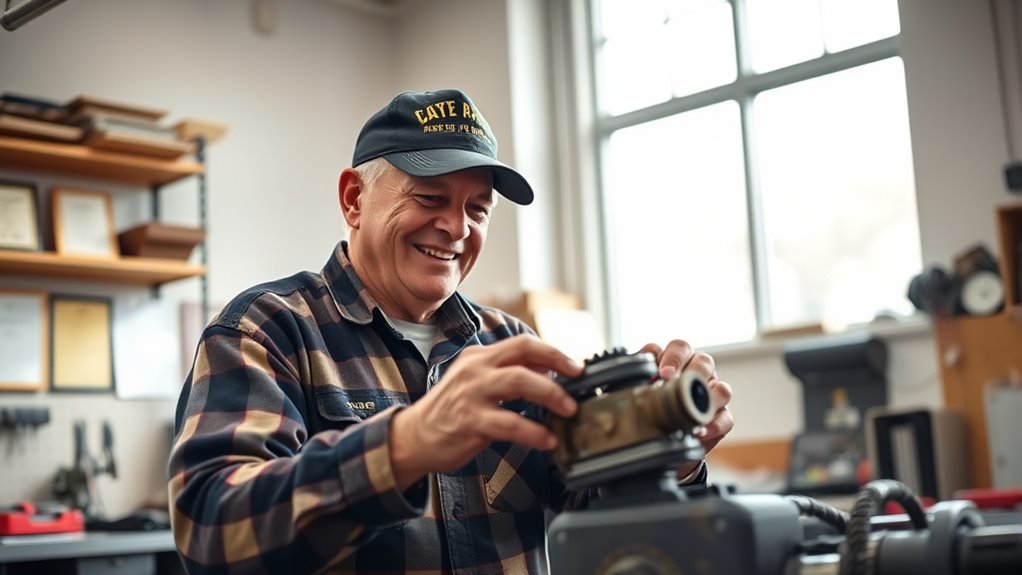Vocational rehabilitation programs help you shift back into the workforce after service by offering re-training tailored to your skills and interests. These programs include skill development, job placement, and hands-on experience. To qualify, you typically need documented disabilities or injuries impacting your work. Many veterans find success through tailored support and resources like counseling and employer partnerships. Keep exploring to discover how these programs can support your career goals and long-term independence.
Key Takeaways
- Vocational rehabilitation programs assist service members in transitioning to civilian careers through tailored re-training and skill development.
- They provide assessments, individualized plans, and support for job placement aligned with personal interests and abilities.
- Programs often include technical training, certifications, and hands-on experience to enhance employability.
- Mental health counseling and emotional support are integral to help veterans overcome employment barriers.
- Resources like VA VR&E services offer comprehensive support, including planning around daily routines and employer partnerships.
Understanding the Purpose of Vocational Rehabilitation

Have you ever wondered how individuals with disabilities or injuries regain their independence and return to the workforce? Vocational rehabilitation programs are designed to help you do just that. They focus on job placement, matching you with suitable work opportunities based on your skills and interests. These programs also prioritize your mental health, understanding that emotional well-being is vital to success. By providing counseling, support, and training, vocational rehab helps you overcome barriers to employment. The goal isn’t just about finding a job; it’s about empowering you to rebuild confidence and achieve long-term independence. Whether you’re recovering from an injury or managing a disability, these programs aim to support your journey back into meaningful work and a more self-sufficient life. Additionally, understanding the role of technology and adaptive tools can significantly enhance your ability to perform tasks and succeed in your employment goals.
Types of Re-Training Programs Available

Once you’ve identified your goals and the barriers you face, exploring the different types of re-training programs available can help you find the best path forward. Vocational rehabilitation offers several options, including skill development courses that enhance your abilities for specific careers. These programs focus on building practical skills aligned with current job market demands. Job placement services are also integral, helping you find suitable employment once you’ve completed your training. Some programs combine classroom instruction with hands-on experience, ensuring you’re prepared for real-world work environments. Whether you need technical training, certification programs, or apprenticeships, these options are designed to equip you with the tools necessary for successful re-entry into the workforce. Choosing the right program depends on your goals and the skills you need to develop. Additionally, privacy policies ensure that your personal information is handled securely throughout your training process.
Eligibility and Application Process

Wondering if you qualify for vocational rehabilitation programs? To be eligible, you typically need a documented disability that impacts your ability to work, and you must be seeking a career shift or re-entry into the workforce. The application process usually involves submitting an initial intake form, providing medical documentation, and participating in an assessment. During this process, the program evaluates your skills, interests, and needs, including any necessary disability accommodations. Keep in mind:
Eligibility requires a documented disability affecting work and a desire for career change or re-entry.
- You might need to demonstrate your disability’s impact on employment
- An individualized plan will be developed based on your goals
- Support is available for career transition and retraining efforts
- Understanding emotional support can be beneficial during the transition process
Once approved, you’ll work with a counselor to access tailored services to help you re-enter the workforce successfully.
Success Stories and Outcomes

Many individuals have achieved remarkable outcomes through vocational rehabilitation programs, demonstrating how tailored support can transform lives. These success stories highlight successful career evolutions and skill development, often leading to meaningful employment. For example, veterans who once faced barriers now thrive in new fields thanks to targeted training. The table below shows common outcomes:
| Outcome | Description | Example |
|---|---|---|
| Career Transition | Moving into new industries or roles | From military to tech |
| Skill Development | Acquiring new skills for employment | Welding, IT certifications |
| Increased Confidence | Gaining independence and motivation | Starting new careers |
Additionally, integrating crochet styles for locs and other creative skills can serve as a form of therapeutic rehabilitation, fostering confidence and self-expression during career development.
Resources and Support for Veterans

Are you aware of the extensive resources available to veterans seeking vocational rehabilitation? These supports are designed to address employment challenges and mental health concerns. Knowing where to turn can markedly improve your transition back into civilian life. You have access to:
Discover vital resources for veterans to overcome employment and mental health challenges during your transition.
- VA Vocational Rehabilitation and Employment (VR&E) services, offering counseling and training
- Mental health support programs to manage stress, anxiety, and other challenges
- Job placement assistance and employer partnerships to ease employment hurdles
These resources aim to empower you, providing the tools you need to overcome obstacles and find meaningful employment. Remember, you’re not alone—help is available to support your mental health, boost your confidence, and guide you toward a successful career after service. Being aware of grocery store hours can also help in planning your daily routines and appointments around your new employment schedule.
Frequently Asked Questions
How Long Does the Re-Training Process Typically Take?
The training duration varies based on your chosen program and individual needs. Typically, it can take several months to a year to complete. During this time, you’ll engage in tailored coursework and skills development. Your program completion depends on hitting specific milestones and mastering required competencies. Keep in mind, the goal is to guarantee you’re fully prepared for your new career, so the length of re-training adapts to your progress and goals.
Are There Financial Assistance Options During Re-Training?
Imagine you’re starting re-training and wonder about financial aid; many programs do offer assistance. For example, if you’re eligible for a vocational rehab program, you might receive financial aid covering tuition, supplies, or living expenses. Program eligibility varies, but most aim to support veterans through re-training. You should check with your local vocational rehab office to understand specific options, ensuring you get the financial help you need during this shift.
Can I Switch Programs if My Interests Change?
If your interests change, you can usually request a program transfer. Vocational rehabilitation programs are designed to accommodate your evolving goals, so you should speak with your counselor about your desire to switch programs. They’ll guide you through the process and help determine if a program transfer is feasible based on your current progress and the availability of alternative options. Don’t hesitate to communicate your interest change to guarantee your training aligns with your new goals.
What Skills Are Most In-Demand in Re-Training Programs?
You might wonder which skills are most in-demand in re-training programs. To find out, you’ll want a skills assessment and career counseling to identify your strengths and industry needs. Currently, tech skills like coding, data analysis, and cybersecurity are highly sought after. Healthcare, skilled trades, and digital marketing also offer promising opportunities. Staying adaptable and updating your skills through targeted training can boost your chances of success in today’s job market.
How Do I Prepare for the Re-Training Program Application?
Preparing for your re-training program application starts with thorough research and proactive planning. Seek out career counseling to identify your interests and strengths, and prioritize mental health support to stay resilient throughout the process. Gather necessary documents, such as IDs and service records, and craft a compelling personal statement. Staying organized and informed will help you confidently navigate the application, opening pathways to new professional pursuits.
Conclusion
Now that you understand the path of vocational rehabilitation, think of it as a bridge guiding you from old challenges to new horizons. With the right programs and support, you can transform setbacks into stepping stones, turning your future into a vibrant tapestry of opportunity. Embrace these resources as a compass, leading you toward renewed purpose and success. Your journey isn’t over—it’s just beginning, with every step paving the way to a brighter tomorrow.











